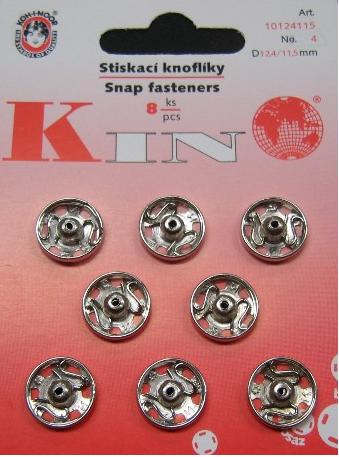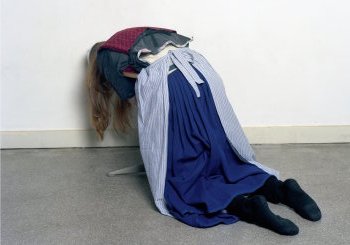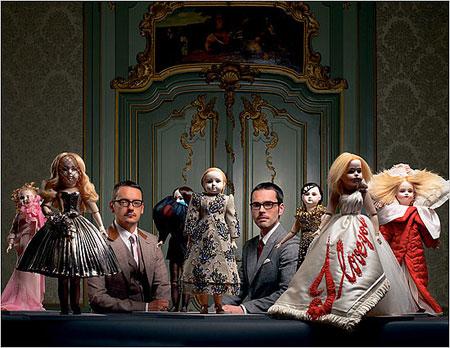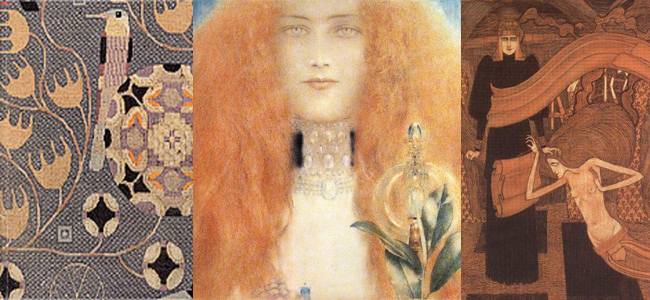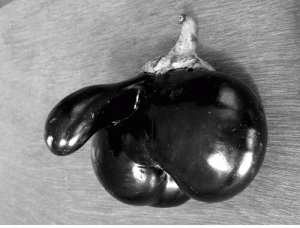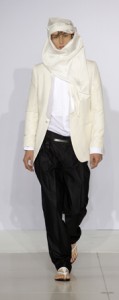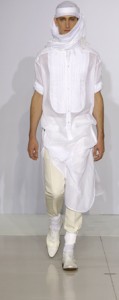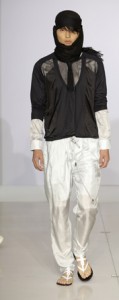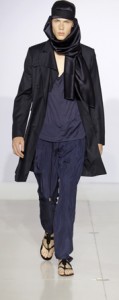The ‘drukknoop’ in the work of Jan Taminiau and San Ming exhibited in the Zuiderzee Museum has lost any function. They were used as decoration on folkloric costumes, inspired on traditional farmer weddings.
Did this typical and especially simple buttons suddenly got another meaning, by using them as Taminiau did?
Which way to look at a button, such a simple everyday object? Buttons are not as simple as you think. Don’t take the object for granted, as once they were beautiful miniature works of art. The aim of my research is to explain a little bit of this big history and show some beautiful examples of handmade buttons.
"Projects" Category
art and buttons/ art in buttons/ art of buttons
Tuesday, October 27, 2009
Portraits without faces
Monday, October 26, 2009
Beautiful or ugly? Smiling or crying? Or maybe thoughtful? Or just silly?…
Lying on the table or looking for something behind it? Or maybe resting in this absurd way? Or perhaps the person is even dead…
You can guess but you don’t know for sure, because the indication of these emotions, feelings, moods and characteristic features, which can immediately tell you the whole story at once, is missing. The face is missing.
Annaleen Louwes, the Dutch photographer, turns people’s faces away from us. She is taking a photograph of a dancer stiffened in one of the passes, a patient from the mental hospital, a duo of theatre makers, or this photo of a young woman in a traditional Dutch costume leaning across the table. A photo made for an exhibition related to the subject of Dutch Folklore.
She raises all these questions and leaves us with no answer.
Dolls and fairytales
Monday, October 26, 2009
In 2008 the dutch design duo Viktor&Rolf held an exhibition at the Barbican Art Gallery in London. They represented their 15 years in the fashion industry with dolls dressed in their most famous creations. These dolls were presented in a spectacular five meters wide and nine feet high doll house (designed by the Dutch architect Siebe Tettero) along with a video presenting 55 other life sized dolls, as well as a montage of their most famous fashion shows to date. Among the fashion shows mentioned was- their 1999 show entitled ‘Babuskha’. Although this, on one level, seems just a fun concept, it had deeper connotations and it was addressing a deeper set of issues -a thin model, beginning only in a light slip was progressively covered in more and more dresses (designed by the duo) until only her face was visible– all making use of dolls as their central theme, or fairytales as the duo themselves put it.
Why have Viktor and Rolf incorporated the use of dolls so frequently into their fashion and what is the significance of a doll?
![]() Dolls_Viktor&Rolf
Dolls_Viktor&Rolf
Inspired by the subject Johanna Illerhag decided to make a set of her own dolls
enjoy also Alexander Calder’s “Circus” 1927
Fragmented concentration
Sunday, October 25, 2009
Gustaf Klimt caused alot of commotion in his time (±1895-1910) by breaking taboes of the current politcal artculture. Although Klimt’s work is know as groundbreaking he used alot of existing elements to which he responded by giving them a different interpretation and thus giving populair themes his own posture. Taking elements of all sorts of areas which are liked and combining those together make the definition of what we nowadays call popart.
Zooming in and taking an image or a situation it’s surrounding away makes it into an statement instead of an narration. This objectifying/ distilling let to an more architectural form in which the most known feature of Klimt is visible namely the decorative side.
Which characteristics did Gustaf Klimt use to open the barrier between art and decorative expression?
The Last Days of Shismaref
Friday, October 16, 2009
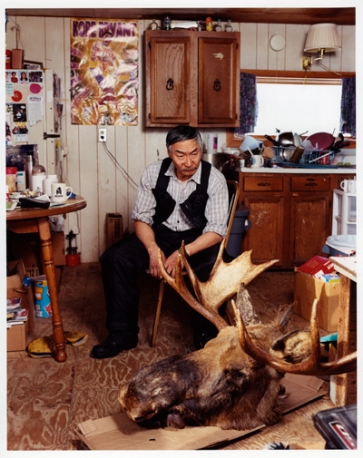
> Fred Goodhope < photograph by Dana Lixenberg
Shismaref is a community settled on an isle close to the Alaskan west coast. The people who live there will be the first victims of the global climate change. Slowly but surely there homeland will disappear in the sea. I do wonder what will happen when these people, with their traditions and folklore, end up in the middle of the mainland American society. There are no concrete plans yet for a re-settlement. In the meantime these inhabitants of Shismaref are forced to survive in refugee centers, which brings about interesting contrasts.
Should there be a search for an isolated site making it possible for their traditions to survive, or should these people lurn how to live in a society as we know it? Questions which I find hard to answere.
The perfect workspace, does it work?
Thursday, October 15, 2009
I find it really interesting to visit an exhibition were artists are working. It gives you a look into the thoughts of these artists. You can see the process.
“Published Workspaces”, I called them in my research.
Published Workspaces make people think, they activate the people’s creative minds. And I think that is a good thing.
In these Workspaces you are often involved in the work process, sometimes you can even help the artist.
In my research I am wondering about the intention of these Published Workspaces, and if they achieve their goals.
Experimental interview
Thursday, October 15, 2009
 What is the connection between Experimental Jetset, Johannes Schwartz and Herman Verkerk?
What is the connection between Experimental Jetset, Johannes Schwartz and Herman Verkerk?
Besides the fact that they are all based in Amsterdam, that they can speak Dutch, they all like to create beautiful and witty designs or images, they like to question their practice, they like to experiment and they actually teamed up together several times, another crucial connection appeared recently: the three of them are going to participate to a collective interview project…
After discovering more about their work, it became obvious that there was something interesting to investigate about their collaboration. What make several people or entities meet and work together? Are they alike or on the contrary, are they so different that they complement each other…?
For that reason, we interviewed them using the same process:
>> AN INTERVIEW IN A SUITCASE
We visited Johannes Schwartz, Experimental Jetset and Herman Verkerk, carrying with us this suitcase. Inside the suitcase, many different objects. Each interviewee was invited to open the suitcase, to browse through it and to freely react to the objects they found in it.
The results were surprising, exciting and very interesting. But when it comes to decide what brought the three of them together and where they meet… you are left free to listen to the interviews and to make up your own mind!
Experimental Jetset, Johannes Schwartz or Herman Verkerk
We are all constructs -made up of mythologies we build ourselfs
Thursday, October 15, 2009
The dutch company VLISCO is producing batik fabrics all of us immediately regard as authentic african. Researching on this one is forced to concern oneself with the peculiar situation of interweaved, imposed and inherited cultural identities.
How does it fit to our stereotype that this fabric, which became such a strong symbol for the celebration of postcolonial independency is actually designd by the dutch? The path opened by this little question leads far. Where do our strereotypes come from? To which extent is cultur original? What do we build our identities out of? What do we regard as typical african, what as european? How do we deal in the postcolonial age with our guilt for colonial crimes?
My research is in particular focusing on „the swing“ made by the british-nigerian artist Yinka Shonibare, who is using the dutch wax as a kind of trademark in his work and somehow seems to be related to all questions mentioned above.
Adolf Loos Versus:
Thursday, October 15, 2009
A lot of “rules” were written for architecture. Not always have they been followed up and also a lot of times they have been discussed by other “writers (philosophers)” / architects.
Adolf Loos was one of these architects who were more philosopher than architect. Even though the whole world listened to what he had to say, his rules were not followed by everyone and not as strict as he had hoped for. This is due to the fact that there were more of these men that had their ideas about architecture. Besides the Ornament & Crime essay there were serveral others like the “Raumplan”, “the Plan Libre” and peoples individual ideas.
Today we don’t design according to a “manual” written by one architect. There are thousands of manuals that inspire us. It’s about what we want ourselves.
‘folklore as a background’
Thursday, October 15, 2009

Clothes are ultimate symbol of the culture. It’s a reference point, a language of people, a language of territories.
The growing of technology affects notions like identity, mobility, displacement and migration They are parts of Hussein Chalayan’s work, and of our daily life too.
Many of us are foreign, from where are we coming from, how are we going to integrated this new folklore with our, this new environment where we are living now?
Here some examples, based on the work of Hussein Chalayan through the question: How technologies and displacement of people can change the folklore today?
Can we talk now about a construction of a bicultural folklore? or a multicultural folklore?
What are we losing, what are we creating new?
Can we say that we still need some reference points?
Willemijn de Greef
Thursday, October 15, 2009
Willemijn de Greef seems to have been interested in the subject “folklore” since she was making her end exam show at the Rietveld academy in 2006. She also seems to be inspired by fishing industry and traditional craft. In her work se is designing various types of jewellery – brooches, rings, necklaces – but her main focus seems to be on the necklaces. When you se her necklaces it is remarkable that they are all very big. – In fact some of them seems impossible to wear. But what is the reason for this size? What is the inspiration for this jewellery designer? And what does she want to say through her jewellery?
Instead of only trying to get answers to my questions through the designer her self I decided also to ask them to people that is part of my personal folklore. Hereby I chose my focus to be, on one hand, at what I can learn about the jewellery of Willemijn de Greef by interviewing people that is part of my personal folklore, and on the other hand, at what I can learn by going directly to the source.
Rietveld to Office
Wednesday, October 14, 2009
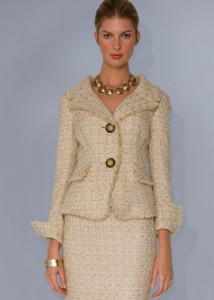 Throughout the history of fashion there has always been a distinction between patterns of clothes that are worn by different groups of people within society. Can we nowadays still speak about variations in patters between different types of people, regardless of the individualization that took place in the past decades? For over a month I have been taking various pictures of patterns from students at the Rietveld Academy in Amsterdam and from people that work for corporate organizations in the Netherlands. This research shows the results.
Throughout the history of fashion there has always been a distinction between patterns of clothes that are worn by different groups of people within society. Can we nowadays still speak about variations in patters between different types of people, regardless of the individualization that took place in the past decades? For over a month I have been taking various pictures of patterns from students at the Rietveld Academy in Amsterdam and from people that work for corporate organizations in the Netherlands. This research shows the results.
Kutten en Lullen
Wednesday, October 14, 2009
In her latest exhibition “Kutten en Lullen”, Dinie Besems shows us a collection of oddly shaped vegetables. All shapes which in some sort resemble a penis or vagina. It’s not her intention to shock us, or make us laugh, she wants to show us these weird mutations of the fruit and vegetables we eat every day. I think this project shows a lot of how Dinie Besems works. She started as a jewelry designer, at the Rietveld. But during her career she’s not afraid to cross borders, cooperate with graphic designers and other artists, and to step away from the conventional “jewelry design”.
With a bit of humor and a lot of concept she stands out among other designers. You never know which way she is going to go, but in the end it’s always something touchable, something that relates to the human body (as in jewelry).
What I noticed is that Dinie Besems often slides over into different diciplines. But in her whole oeuvre I can detect an overall interest in the communicative values of graphic design. Magazines, posters, her website and other collaborations with well known graphic designers. So where does that come from? How does she see this crossing over and are graphic design and jewelry that far apart as I thought they were?
Tichelaar Makkum – In Tradition and Presence
Wednesday, October 14, 2009
What is special about Tichelaar Makkum porcelain? What creates the fascination of it, and what can this tell us about the world of fashion and design?
These are the questions that I will seek to answer in my research on the Royal Tichelaar Makkum porcelain factory.
Draag mijn kleding, leer mij kennen en kom dichterbij.
Wednesday, October 14, 2009
Hoe kunnen de nederlandse en de moslim (arabische) bevolking dichter bij elkaar worden gebracht?
Van Benthum doet een flirt met de kleding uit arabie in zijn kleding productie RADIANT.
Ik heb gelezen dat hij zich alleen op het uiterlijk van de kleding focust maar gaat verder niet in op de diepere betekenis die hij creëert met deze connectie die hij maakt.
Door blanke jongens te laten lopen in zijn kleding geïnspireerd op Arabische klederdracht.
Deze combinatie van een Europese jongen in Arabische klederdracht doet je dan ook aan het denken zeker omdat het westen en de moslim landen steeds minder goed met elkaar overweg kunnen.
Van Benthum zijn kleding word niet gedragen op straat en deze blijft op de catwalk zelf waardoor deze kleding een mooi stuk kleding blijft maar niet gaat werken op de manier als deze ook daadwerkelijk op straat zou worden gedragen.
Op straat zou deze kleding gaan werken op een andere manier een manier waarop je mensen aan het denken zet en zich laat afragen wat doe die blanke jongen in Arabische kleding en de moslimse bevolking zou misschien een minder grote afstand voelen.
Dit zou deze twee culturen via kleding dichter bij elkaar kunnen brengen
Familie uitwisseling project.
zo zou je een Nederlandse familie uit een oer-Hollands dorp een week van kleding en huis kunnen laten ruilen met een traditionele Marokkaanse familie in Amsterdam.
deze twee families zullen voor een week van leven ruilen en zo meer begrip voor elkaar kunnen krijgen en zouden zij voor elkaar niet meer onbekenden zijn.
de Nederlandse familie zou bijvoorbeeld zo over straat lopen boodschappen doen een keer de moskee bezoeken Marokkaans eten klaarmaken en de vader moeder en kinderen zouden allemaal hun rol vervullen zoals de eigenlijke familie zou doen.
dit zelfde geld voor de Marokkaanse familie die voor een week zullen leven als deze oer Hollandse familie.
Volgens mij zal dit deze twee verschillende culturen dichter bij elkaar brengen zij zullen elkaar beter leren kennen leren begrijpen en de vervreemding van elkaar tegengaan.
The ‘Wiener Werkstätte’ and the concept ‘Gesamtkunstwerk’
Wednesday, October 14, 2009
At the beginning of the 20th century Josef Hoffmann, Kolo Moser and the industrialist Fritz Werndorfer founded the ‘Wiener Werkstätte’. In order to protect traditional handicraft from mass-production they designed exclusive handmade everyday objects and gave them the aura of art. At the same time they tried to find an alternative to old representative art forms favored by the rulers of Austria which shaped the picture of Vienna at this time. When they started to design architecture which they filled with their handmade furniture and their handmade objects their work became a concept that led to an idea of a different society based on pure aesthetics: they tried to create a ‘Gesamtkunstwerk’.
Under which circumstances could such a concept develop? The design of the ‘Wiener Werkstätte’ is still very modern and popular while the concept of the ‘Gesamtkunstwerk’ is not relevant anymore. But why? Do we need a similar utopia today? If one wants to get an idea ‘why’ one has to take a closer look at the development of the concept ‘Gesamtkunstwerk’ in relation to its historic background.

